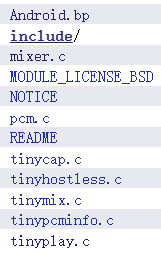tinyalsa剖析
external/tinyalsa/

/external/tinyalsa/include/tinyalsa/
在该目录下,仅存在一个asoundlib.h的头文件,这个文件应该是向hal层提供一些接口。
1. Android.bp
查看代码
cc_library {
name: "libtinyalsa",
host_supported: true,
vendor_available: true,
vndk: {
enabled: true,
},
srcs: [
"mixer.c",
"pcm.c",
],
cflags: ["-Werror", "-Wno-macro-redefined"],
export_include_dirs: ["include"],
local_include_dirs: ["include"],
target: {
darwin: {
enabled: false,
},
},
}
cc_binary {
name: "tinyplay",
host_supported: true,
srcs: ["tinyplay.c"],
shared_libs: ["libtinyalsa"],
cflags: ["-Werror"],
target: {
darwin: {
enabled: false,
},
},
}
cc_binary {
name: "tinycap",
srcs: ["tinycap.c"],
shared_libs: ["libtinyalsa"],
cflags: ["-Werror"],
}
cc_binary {
name: "tinymix",
srcs: ["tinymix.c"],
shared_libs: ["libtinyalsa"],
cflags: ["-Werror", "-Wall"],
}
cc_binary {
name: "tinyhostless",
srcs: ["tinyhostless.c"],
shared_libs: ["libtinyalsa"],
cflags: ["-Werror"],
}
cc_binary {
name: "tinypcminfo",
srcs: ["tinypcminfo.c"],
shared_libs: ["libtinyalsa"],
cflags: ["-Werror"],
}该Android.bp文件向外界提供了:
1)提供了libtinyalsa库,个人认为还是hal层直接调用。通过这个库调用到底层。该库是由源文件pcm.c和mixer.c生成;
2)提供了tinyplay, tinycap, tinymix, tinyhostless, tinypcminfo等可执行程序,这些程序仅仅是为了测试。
2. tinyplay程序分析
#include <tinyalsa/asoundlib.h>
#include <stdio.h>
#include <stdlib.h>
#include <stdint.h>
#include <string.h>
#include <signal.h>
#define ID_RIFF 0x46464952
#define ID_WAVE 0x45564157
#define ID_FMT 0x20746d66
#define ID_DATA 0x61746164
//WAV文件遵循RIFF规则,其内容以区块(chunk)为最小单位进行存储。
//chunk就有id和size
struct riff_wave_header {
uint32_t riff_id; //riff_id 固定死,填入 RIFF
uint32_t riff_sz; //riff_sz 为文件长度减去 ID 和 Size 的长度,即 fileSize - 8
uint32_t wave_id; //如果wave_id是wav,表示后面有 Format chunk 和 Data chunk。
};
//每一个chunk都有id和size.
//id是以大端进行存储的。
struct chunk_header {
uint32_t id;
uint32_t sz;
};
struct chunk_fmt {
uint16_t audio_format;//音频格式
uint16_t num_channels; //通道数
uint32_t sample_rate; //采样率
uint32_t byte_rate; //传输速率,每秒的字节数。计算公式为:sample_rate*num_channels*bits_per_sample/8
uint16_t block_align; //块对齐,告知播放软件一次需要处理多少字节。公式为bits_per_sample*num_channels/8
uint16_t bits_per_sample;//采样位数,一般有8/16/24/32/64,值越大,对声音的还原度越高
};
static int close = 0;
void play_sample(FILE *file, unsigned int card, unsigned int device, unsigned int channels,
unsigned int rate, unsigned int bits, unsigned int period_size,
unsigned int period_count);
void stream_close(int sig)
{
/* allow the stream to be closed gracefully */
signal(sig, SIG_IGN);
close = 1;
}
int main(int argc, char **argv)
{
FILE *file;
struct riff_wave_header riff_wave_header;
struct chunk_header chunk_header;
struct chunk_fmt chunk_fmt;
unsigned int device = 0;
unsigned int card = 0;
unsigned int period_size = 1024; //一个period中有1024个帧
unsigned int period_count = 4; //缓冲区的大小为4个period_size的大小
char *filename;
int more_chunks = 1;
if (argc < 2) { //参数不能少于2个
fprintf(stderr, "Usage: %s file.wav [-D card] [-d device] [-p period_size]"
" [-n n_periods] \n", argv[0]);
return 1;
}
filename = argv[1]; //文件名称
file = fopen(filename, "rb"); //打开文件
if (!file) {
fprintf(stderr, "Unable to open file '%s'\n", filename);
return 1;
}
//从file中读取1个对象,该对象的大小为sizeof(riff_wave_header),即12个字节
fread(&riff_wave_header, sizeof(riff_wave_header), 1, file);
//头部必须是RIFF, type必须是wave
if ((riff_wave_header.riff_id != ID_RIFF) ||
(riff_wave_header.wave_id != ID_WAVE)) {
fprintf(stderr, "Error: '%s' is not a riff/wave file\n", filename);
fclose(file);
return 1;
}
do {
//这个地方的思想就是通过id来找format chunk和data chunk,当找到的id不是这两个之一,
//那么就会利用fseek跳过chunk_header.size
//对于第一次循环,做注释
//此时的fseek指针为0+12个字节处。从目前fseek指向的地址处,读取1个对象
//该对象的大小为sizeof(chunk_header),即为8
//第二次循环:我们假设上一次已经找到了format_chunk,接下来就是找取data_chunk的过程了。
fread(&chunk_header, sizeof(chunk_header), 1, file);
switch (chunk_header.id) {
case ID_FMT:
//此时fseek指向0+12+8处,从fseek指向的地址处,读取1个对象,
//该对象的大小为sizeof(chunk_fmt),即16个字节。
fread(&chunk_fmt, sizeof(chunk_fmt), 1, file);
/* If the format header is larger, skip the rest */
//一般来说chunk_header.size的大小等于chunk_fmt的大小,但是不能排除特殊情况。如果大于,那么使fseek跳过
//多余的那些字节。为什么会这么处理呢?因为我们已经获取到了音频文件的格式,如声道数、采样率等等。接下来,
//我们需要找到data所在的chunk.
if (chunk_header.sz > sizeof(chunk_fmt))
fseek(file, chunk_header.sz - sizeof(chunk_fmt), SEEK_CUR);
break;
case ID_DATA:
/* Stop looking for chunks */
more_chunks = 0; //一旦找到了data_chunk,那么将该变量置0.说明,我们不需要下一次循环了。接下里处理数据就好了
break;
default:
/* Unknown chunk, skip bytes */
fseek(file, chunk_header.sz, SEEK_CUR);
}
} while (more_chunks); //第一次循环时,more_chunks为1,那么接下来进行第二次循环
/* parse command line arguments */
argv += 2; //如果直接调用tinyplay a.wav,那么只存在argv[0] = tinyplay, argv[1] = a.wav
while (*argv) {
if (strcmp(*argv, "-d") == 0) {
argv++;
if (*argv)
device = atoi(*argv);
}
if (strcmp(*argv, "-p") == 0) {
argv++;
if (*argv)
period_size = atoi(*argv);
}
if (strcmp(*argv, "-n") == 0) {
argv++;
if (*argv)
period_count = atoi(*argv);
}
if (strcmp(*argv, "-D") == 0) {
argv++;
if (*argv)
card = atoi(*argv);
}
if (*argv)
argv++;
}
play_sample(file, card, device, chunk_fmt.num_channels, chunk_fmt.sample_rate,
chunk_fmt.bits_per_sample, period_size, period_count);
fclose(file);
return 0;
}
int check_param(struct pcm_params *params, unsigned int param, unsigned int value,
char *param_name, char *param_unit)
{
unsigned int min;
unsigned int max;
int is_within_bounds = 1;
min = pcm_params_get_min(params, param);
if (value < min) {
fprintf(stderr, "%s is %u%s, device only supports >= %u%s\n", param_name, value,
param_unit, min, param_unit);
is_within_bounds = 0;
}
max = pcm_params_get_max(params, param);
if (value > max) {
fprintf(stderr, "%s is %u%s, device only supports <= %u%s\n", param_name, value,
param_unit, max, param_unit);
is_within_bounds = 0;
}
return is_within_bounds;
}
int sample_is_playable(unsigned int card, unsigned int device, unsigned int channels,
unsigned int rate, unsigned int bits, unsigned int period_size,
unsigned int period_count)
{
struct pcm_params *params;
int can_play;
params = pcm_params_get(card, device, PCM_OUT);
if (params == NULL) {
fprintf(stderr, "Unable to open PCM device %u.\n", device);
return 0;
}
can_play = check_param(params, PCM_PARAM_RATE, rate, "Sample rate", "Hz");
can_play &= check_param(params, PCM_PARAM_CHANNELS, channels, "Sample", " channels");
can_play &= check_param(params, PCM_PARAM_SAMPLE_BITS, bits, "Bitrate", " bits");
can_play &= check_param(params, PCM_PARAM_PERIOD_SIZE, period_size, "Period size", " frames");
can_play &= check_param(params, PCM_PARAM_PERIODS, period_count, "Period count", " periods");
pcm_params_free(params);
return can_play;
}
void play_sample(FILE *file, unsigned int card, unsigned int device, unsigned int channels,
unsigned int rate, unsigned int bits, unsigned int period_size,
unsigned int period_count)
{
struct pcm_config config;
struct pcm *pcm;
char *buffer;
int size;
int num_read;
memset(&config, 0, sizeof(config));
config.channels = channels;
config.rate = rate;
config.period_size = period_size;
config.period_count = period_count;
if (bits == 32)
config.format = PCM_FORMAT_S32_LE;
else if (bits == 24)
config.format = PCM_FORMAT_S24_3LE;
else if (bits == 16)
config.format = PCM_FORMAT_S16_LE;
config.start_threshold = 0;
config.stop_threshold = 0;
config.silence_threshold = 0;
if (!sample_is_playable(card, device, channels, rate, bits, period_size, period_count)) {
return;
}
pcm = pcm_open(card, device, PCM_OUT, &config);
if (!pcm || !pcm_is_ready(pcm)) {
fprintf(stderr, "Unable to open PCM device %u (%s)\n",
device, pcm_get_error(pcm));
return;
}
size = pcm_frames_to_bytes(pcm, pcm_get_buffer_size(pcm));
buffer = malloc(size);
if (!buffer) {
fprintf(stderr, "Unable to allocate %d bytes\n", size);
free(buffer);
pcm_close(pcm);
return;
}
printf("Playing sample: %u ch, %u hz, %u bit\n", channels, rate, bits);
/* catch ctrl-c to shutdown cleanly */
signal(SIGINT, stream_close);
do {
num_read = fread(buffer, 1, size, file);
if (num_read > 0) {
if (pcm_write(pcm, buffer, num_read)) {
fprintf(stderr, "Error playing sample\n");
break;
}
}
} while (!close && num_read > 0);
free(buffer);
pcm_close(pcm);
}